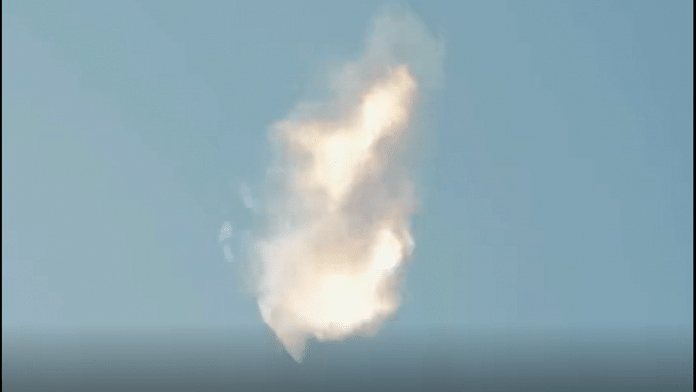Bengaluru: SpaceX’s super heavy lift launch vehicle Starship exploded Thursday, minutes after the world’s most powerful rocket launched from Texas, the US, for its maiden test flight.
During a 90-minute test flight, the 120m tall two-stage rocket, which is also the world’s heaviest launch vehicle, was supposed to reach 233 km above the Earth. But the first stage failed to separate at an altitude of 39 km, exploding into flames.
“Starship experienced a rapid unscheduled disassembly before stage separation,” SpaceX said, in a statement on Twitter,
After the explosion, SpaceX CEO Elon Musk tweeted that the next flight would take place in a few months.
Congrats @SpaceX team on an exciting test launch of Starship!
Learned a lot for next test launch in a few months. pic.twitter.com/gswdFut1dK
— Elon Musk (@elonmusk) April 20, 2023
Understanding the launch
The launch vehicle is made up of the Super Heavy booster and the Starship spacecraft, together known as Starship. This is the vehicle that NASA will fly its astronauts on with the Artemis 3 mission to the Moon’s South Pole in 2025.
It is also designed to eventually launch both crew and cargo to Mars as well.
Powered by 33 Falcon Raptor engines, the Super Heavy booster is expected to become reusable in the future. In this test, the booster was supposed to have separated over the Gulf of Mexico as the rocket flew over it towards Hawaii.
Starship is also designed to be fully reusable, but in this test flight, Booster 7 and Ship 24 — the versions of prototypes being tested — were to fall into the Pacific Ocean after burning up in the atmosphere.
The test mission was supposed to reach orbital velocity (at which artificial satellites remain in orbit) but not complete a full orbit of the Earth. At 233 km, it should have reached a velocity of 28,160 kmph.
The 50m tall Starship’s upper stage was supposed to separate from the Super Heavy three minutes into the flight, but it did not go according to plan. The connected stages started to tumble and exploded within four minutes after launch.
Also Read: Soon, 2 giant leaps for India Inc: The 1st private rocket launch, then a 3D printed rocket
First flight of integrated model
While the Super Heavy boosters and Starship prototypes have been tested separately several times earlier, this flight was the first for the integrated model.
Reactions to the flight have been overwhelmingly positive, with reports of employees at SpaceX headquarters bursting into applause after the explosion.
SpaceX’s first attempt to launch the vehicle was scheduled for 17 April, but was abandoned due to a frozen valve. This was the first successful effort to launch Starship.
Over the live webcast, Space X engineers also explained how getting the vehicle to fly was a giant success. “This is the first test flight of Starship, and the goal is to gather data, clear the pad and get ready to go again,” SpaceX Principal Integration Engineer John Insprucker said on the livestream. “Starship gave us a rather spectacular end to what was truly an incredible test.”
Development of Starship began back in 2005, and its basic architecture was revealed in 2016. Initially called the Interplanetary Transport System, its name was subsequently changed to BFR, which stood for Big F- Rocket.
Later, Musk changed the expansion to Big Falcon Rocket. Ultimately, the deep-space transport vehicle became Starship.
The new Raptor engines used in the flight are fuelled by liquid methane and liquid oxygen — both of which can theoretically be produced on Mars, allowing for a return journey in the future. When the vehicle becomes functional, it will be able to carry 150,000 kg of cargo to orbit.
(Edited by Tony Rai)
Also Read: How can India get its own Elon Musk? ISRO Chair Somanath says agency has key role to play



